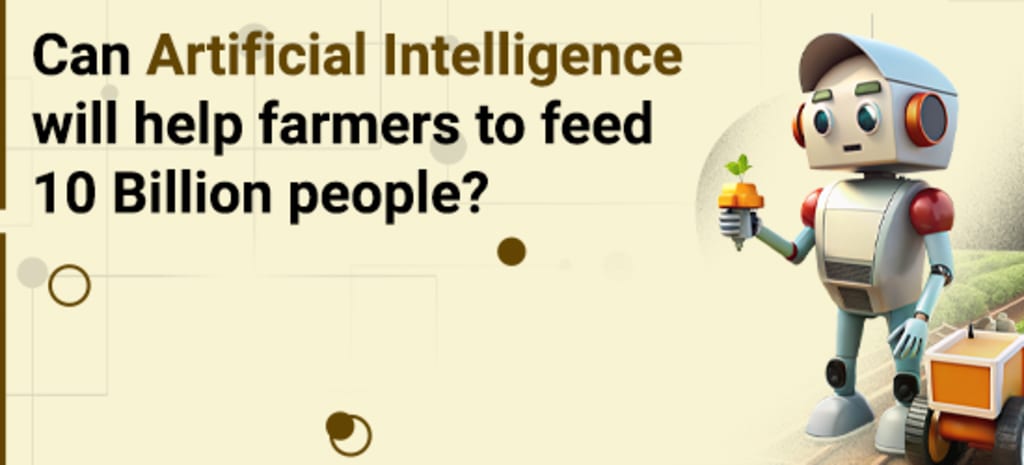Can artificial intelligence help farmers to feed 10 Billion people?
Openai/Chatgpt development services

Agriculture and farming are among the most traditional professions that still exist today. The progress of technology has revolutionised seed sowing and harvesting procedures. Furthermore, the widespread use of robotics and analytical instruments has made it easier to inspect yield quality. It has improved a variety of agricultural jobs across the entire food supply chain. Above all, the most recent innovation in artificial intelligence functions by outperforming the human brain. It provides breakthrough statistics and results for a successful expansion.
AI helps in analysing and estimating data
This contemporary technology has completely transformed growing, sowing, and cultivation functionalities. It helps the farmers analyse the quality of seeds and predict the weather conditions in a real-time scenario. Along with that, it contributes to presenting the estimates of bountiful yield and makes proper utilization of the resources. It can determine the quality of soil and help in planning for the next yield by counting the data points. Thus, it has renovated the way how earlier agriculture was perceived.
AI supports improving the precision of farm points
AI is used to determine the accuracy level of seasonal forecasting models. It possesses the capability to precisely predict the climatic pressure in the coming months and plan for the sowing period. The information obtained through AI holds a significant position for farmers in growing and nurturing abundant harvests. In addition to that, AI has been taken to space to analyze the overall condition of crops and inspect the problem in real-time. Thus, AI solutions allow the detection of an early-stage problem in crops supported by Deep Learning and Computer vision.
AI helps to improve the precision of farm locations
AI is used to evaluate the accuracy of seasonal forecasting models. It can accurately estimate climatic pressure in the following months and plan for the sowing season. The knowledge collected through AI plays an important role for farmers in cultivating and sustaining big harvests. In addition, AI has been deployed in space to analyse the overall status of crops and inspect the problem in real time. Thus, AI technologies enable the diagnosis of an early-stage problem in crops using Deep Learning and Computer Vision.
AI deals with the loss of employment
During the traditional era, only a few countable persons entered the agricultural industry. This leads to a labour shortage. To address manpower shortages, AI Agricultural ChatBots have taken the place of humans. These bots are more productive and efficient than humans, generating lump sum yields quickly while maintaining quality standards. Beyond that, it reduces labour costs and the possibility of weeds. They will make suggestions and consult with farmers to solve agricultural difficulties. It includes cognitive advancement, which folds the turns and extracts the best from acres to feed a 10 billion-person economy.
AI brings automation to harvesting
Behind the automation of harvesting, a supervisor traces the movement and tilting growth of crops. It can spray herbicides on the entire field with a speedy process and harvest crops at significant rates. It will maintain the production of crops and enable the labourers to focus on other tasks. For instance, the Harvest CROO Robotics Strawberry robot is designed to harvest and pack strawberries without the involvement of any human factor.
The role of artificial intelligence in the agricultural information management cycle
Managing agricultural data using AI can be advantageous in numerous ways:
Risk management
Predictive analytics helps farmers reduce errors in their procedures.
AI uses plant growth data to recommend crops that are more resistant to adverse weather, disease, and pests.
Soil and crop health analysis.
AI algorithms can examine the chemical composition of soil samples to detect which nutrients may be deficient. AI may help discover and predict crop diseases.
Crop feeding
AI in irrigation can help find optimal crop feeding patterns and nutrient delivery schedules, as well as anticipate the best agronomic product combination. AI can enhance crop production and forecast optimal harvest times.
What is the future of artificial intelligence in agriculture?
AI is likely to play an increasingly important role in agriculture and food sustainability in the future years. Agriculture has always relied heavily on technology, from basic tools to irrigation, tractors, and artificial intelligence. Each advancement has boosted efficiency while minimising farming obstacles.
Furthermore, the advantages of AI in agriculture are apparent. Smart agricultural technologies, intelligent automation, and AI-powered goods automate repetitive time-consuming processes, freeing up staff to focus on more strategic operations that require human judgement. Increasingly affordable computer vision, combined with agricultural robotics, has the potential to drive AI advances in farming.
Climate change, environmental issues, and rising food consumption all represent challenges that AI can help address. It will transform current agriculture by enhancing efficiency, sustainability, resource allocation, and real-time monitoring, resulting in healthier and higher-quality products.
However, you cannot simply buy AI and start utilising it. AI is not a tangible object; rather, it is a collection of technologies that have been mechanised through programming. In essence, an AI system thinks in the same manner that people do: it learns first and then solves issues using data. The industry will need to alter to accommodate the AI-driven transformation of agriculture. Farmers should be educated and schooled on how to employ AI-powered solutions.
Conclusions
Agriculture and food production are among humanity's most important industries. Agriculture's first products are utilised as inputs in numerous multi-factor distributed supply chains, which include four clusters or stages of the supply chain (preproduction, production, processing, and distribution) before reaching the final user or customer.
About the Creator
Matthew Brain
Matthew Brain, an experienced content writer, enjoys sharing his thoughts on various online delivery firms, eCommerce, on-demand business models, and so on.
https://www.swayaminfotech.com/taxi-booking-app-like-uber-clone-app/






Comments
There are no comments for this story
Be the first to respond and start the conversation.